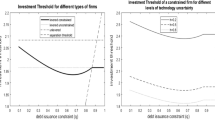Abstract
In the theory of financial intermediation, bank debt is often characterized as being more readily renegotiable than public debt. Banks are also conjectured to gain valuable non-public information through closer monitoring. Given these features, bank debt can theoretically be more flexible than public debt and can lead to better investment/liquidation decisions. We investigate this possibility using a sample of firms facing the important decision of whether to reinvest the proceeds from asset sales or whether to distribute the proceeds to debtholders. While higher levels of leverage are associated with an increased probability of distributing proceeds to creditors, this relationship is significantly muted for bank debt as opposed to public debt. This finding is consistent with the conjecture that bank debt provides enhanced flexibility when compared to public debt. Further we find that asset sale announcement period abnormal stock returns are increasing in firms’ use of bank debt, but not public debt. This suggests that market participants believe that banking relationships are leading to better decision making for this particular type of investment/liquidation decision. We find no significantly different effects of bank vs. public debt on the initial decision to undertake an asset sale in the first place. Thus, in the context of asset sales, the main observable difference arises in the use of proceeds decision, rather than the initial asset sale decision.
Similar content being viewed by others
Notes
Details gathered from Ico’s 8-K SEC filing, dated September 9, 2002. As we discuss in more detail below in our data section, we do not treat loans from private financial companies as substantively different from bank loans for the purposes of our study, as both types of loans are similar in terms of their crucial features as compared to public debt. In contrast to public debt, both types of loans come from relatively concentrated private lenders, and both types of loans are frequently renegotiated (Roberts and Sufi 2009).
Given issues of potential lender liability, one might expect such formal restrictions to be relatively rare compared to less formal agreements reached when a covenant is waived (or not enforced) without formally renegotiating and amending a loan agreement.
This finding is the primary overlap between Datta et al. (2003), and our study. Beyond this, the focus and analyses of the two papers are quite distinct. Datta et al. (2003) do not examine the use of proceeds decision or the initial decision on whether or not to sell assets. Their primary focus is instead factors that lead to wealth increases for buying and selling firms. We have also been able to draw from the literature on asset sales post Datta et al. (2003), to extend the analysis of the determinants of stock returns for selling firms. Thus we are able to include a more complete set of control variables in our selling firm announcement return regressions, and examine differential effects depending on use of proceeds.
Sources searched include Dow Jones Newswires, Press Release Wires, Reuters News, and The Wall Street Journal. The search keyword was the following: (seller name or buyer name) and (divest* or merg* or sell or sale or use or used or proceeds or cash or purchase price or debt or repurchases or repurchase or buy back or buybacks or dividend or invest or reinvest or investment or investments or fund or funds).
Carey et al. (1998) document that, while both banks and finance companies tend to lend to “information-problematic” firms, finance companies tend to lend to riskier borrowers than banks. Thus finance companies appear to match the role of informed intermediary in the theoretical literature at least as well as banks.
We exclude from the bank category any notes that are neither senior nor secured. Carey et al. (1998), document that almost none of the bank and finance company loans in their database were subordinate to other issues and a large majority, particularly from finance companies, were secured.
Much of the classification information comes from the footnotes to long-term debt in company 10-K reports. We restrict our sample to firms for which we can access the most recent 10-K prior to the asset sale announcement online.
Due to the small equity repayment sample our focus in the paper is largely on the debt repayment and retention sample.
The corresponding difference in median leverage ratios is also highly significant.
Harford and Li (2007) provide related evidence using the flip side of an asset sale transaction: acquisitions. They find evidence that CEO wealth tends to increase following merger transactions, even in cases where shareholders are worse off.
In unreported tests, we also examine the degree in which or results are driven by firms of a certain size. To test this, we divide the sample into thirds by asset size and re-run the specifications in Panel A of Table 3. Here, we find no significant difference between the debt payout and retention decision by firm size.
Due to the small sample size of Panel B in Table 3 we only report robustness and extensions on Panel A.
The p-values reported in the table and text for abnormal returns are based on t-tests on the cumulative abnormal returns. If we use a z-test on standardized cumulative abnormal returns (as in equation 4.4.24 of Campbell et al. 1997), the returns to both the retention and debt payout sample are significant at the 1 % confidence level and the returns to the retention payout sample is significant at 5 %. As discussed previously, we hesitate to draw any strong conclusions from the equity payout sample given its small size.
The patterns of returns are also quite similar if we focus on 1-day abnormal returns rather than 3-day.
The significance of the bank debt variable is 5 % (p = 0.029) if we explicitly control for the financial crisis period of 2007, 2008, and 2009. As such, it appears that the benefit of bank debt was somewhat muted during the crisis period. In general, the results for the bank debt variable are consistently at 5 % throughout Table 6 if we control for the financial crisis.
John and Ofek (1995) find that announcement returns to asset sales are increasing in the extent to which the sales increases the focus of the company (reduces diversification).
As a robustness check (unreported) we added two additional variables from Bates (2005) to the model in column 3 of Table 5. These variables are an indicator for whether the firm had been paying a common dividend and a measure of income volatility (defined as the standard deviation of the operating income to asset ratio over the five fiscal years preceding the asset sale). In this specification, the coefficient on neither of the two variables is statistically different from zero.
In unreported tests we also control for industry at the four digit SIC level. Results are relatively unchanged.
References
Alexander GJ, Benson GP, Kampmeyer JM (1984) Investigating the valuation effects of announcements of voluntary corporate selloffs. J Finance 39:503–517
Bates TW (2005) Asset sales, investment opportunities, and the use of proceeds. J Finance 60:105–135
Berlin M, Loeys J (1988) Bond covenants and delegated monitoring. J Finance 43:397–412
Berlin M, Mester LJ (1992) Debt covenants and renegotiation. J Financ Intermed 2:95–133
Campbell JY, Lo AW, and MacKinlay AC (1997) The Econometrics of Financial Markets, Princeton University Press
Carey M, Post M, Sharpe SA (1998) Does corporate lending by banks and finance companies differ?Evidence on specialization in private debt contracting. J Finance 53:845–878
Chemmanur TJ, Fulghieri P (1994) Reputation, renegotiation, and the choice between bank loans and publicly traded debt. Rev Financ Stud 7:475–506
Datta S, Iskandar-Datta M, Raman K (2003) Valuation in corporate asset sales: the role of managerial performance and lender monitoring. J Bank Financ 27:351–375
Diamond DW (1991) The choice between bank loans and directly placed debt. J Polit Econ 99:689–721
Elyasiani E, Goldberg LG (2004) Relationship lending: a survey of the literature. J Econ Bus 56:315–330
Gilson SC, John K, Lang LHP (1990) Troubled debt restructurings: an empirical study of private reorganization of firms in default. J Financ Econ 27:315–353
Harford J, Li K (2007) Decoupling CEO wealth and firm performance: the case of acquiring CEOs. J Finance 62:917–949
Hite GL, Owers JE, Rogers RC (1987) The market for interfirm assets sales: partial Sell-offs and total liquidations. J Financ Econ 18:229–252
Hoshi T, Kashyap A, Scharfstein D (1990) The role of banks in reducing the costs of financial distress in Japan. J Financ Econ 27:67–88
Houston J, James C (1996) Bank information monopolies and the mix of private and public debt claims. J Finance 51:1863–1889
Jain PC (1985) The effect of voluntary sell-off announcements on shareholder wealth. J Finance 40:209–224
Jensen MC (1986) Agency costs of free cash flow, corporate finance, and takeovers. Am Econ Rev 76:323–329
John K, Ofek E (1995) Asset sales and increase in focus. J Financ Econ 37:105–126
Johnson SA (1997) An empirical analysis of the determinants of corporate debt ownership structure. J Financ Quant Anal 32:47–69
Johnson SA (1998) The effect of bank debt on optimal capital structure. Financ Manag 27:47–56
Kang J-K, Lee I, Na HS (2010) Economic shock, owner-manager incentives, and corporate restructuring: evidence from the financial crisis in Korea. J Corp Financ 16:333–351
Lang L, Poulsen A, Stulz R (1995) Asset sales, firm performance, and the agency cost of managerial discretion. J Financ Econ 37:3–37
Morck R, Shleifer A, Vishny R (1988) Management ownership and market valuation: an empirical analysis. J Financ Econ 20:293–315
Morris S, and Shin HS (2002) Coordination risk and the price of debt, Working paper, Yale University
Nini G, Smith DC, Sufi A (2009) Creditor control rights and firm investment policy. J Financ Econ 92:400–420
Ongena S, and Smith DC (2000) Bank relationships: A review, in Performance of Financial Institutions: Efficiency, Innovation, Regulation, edited by Harcker PT and Zenios SA, Cambridge University Press
Rajan RG (1992) Insiders and outsiders: the choice between informed and arm’s-length debt. J Finance 47:1367–1400
Roberts MR, Sufi A (2009) Renegotiation and financial contracts: evidence from private credit agreements. J Financ Econ 93:159–184
Schlingemann FP, Stulz RM, Walkling RA (2002) Divestitures and the liquidity of the market for corporate assets. J Financ Econ 64:117–144
Smith CW, Warner JB (1979) On financial contracting: an analysis of bond covenants. J Financ Econ 7:117–161
Warusawitharana M (2008) Corporate asset purchases and sales: theory and evidence. J Financ Econ 87:471–497
Yang L (2008) The real determinants of asset sales. J Finance 63:2231–2262
Author information
Authors and Affiliations
Corresponding author
Rights and permissions
About this article
Cite this article
Fee, C.E., Pierce, J.R., Seo, H. et al. Bank Debt, Flexibility, and the Use of Proceeds from Asset Sales. J Financ Serv Res 46, 77–97 (2014). https://doi.org/10.1007/s10693-013-0173-3
Received:
Revised:
Accepted:
Published:
Issue Date:
DOI: https://doi.org/10.1007/s10693-013-0173-3




